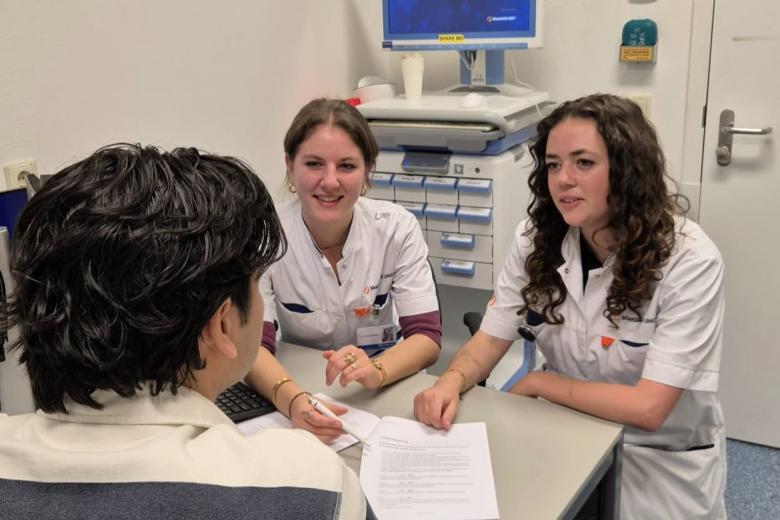Weighing molecules and solving problems
Being presented with a problem and trying to solve it: that is what attracts Michiel Vandenbosch to science. As manager of the Imaging Mass Spectrometry (IMS) CORE Facility within M4i, he works in the field of mass spectrometry. This technique allows scientists to identify the composition of a substance based on the weight of its molecules. One of the techniques used in the Facility was named Method of the Year 2024 by Nature. Michiel: “I would love it if something we are doing here one day forms the basis for a solution in the hospital.”
Michiel is from Sint-Truiden, Belgium. During his PhD in forensic toxicology, he used mass spectrometry a lot. “After that, I spent six months in Vienna, where I met people from Maastricht University,” Michiel says. “Then I joined M4i for a postdoc, after which I became manager of the IMS CORE Facility. M4i is the largest imaging mass spectrometry facility in Europe and the second largest in the world. The biggest one is in the United States, but in Europe we are the leaders in the field. The word ‘CORE’ stands for ‘Collaboration, Open Research and Education’. The idea is to share our knowledge and techniques with others, both within Maastricht University and beyond. I spend half of my time managing the Facility, and the other half doing research.”
Weight of molecules
What is mass spectrometry? “Everything we see around us is made up of molecules,” Michiel explains. “Each molecule has a specific weight, which we can measure. When we receive a sample of a substance or tissue, we can use mass spectrometry to determine which molecules are present based on their weight. We go a step further and also visualise the spatial distribution of these molecules. This means we can show where a molecule is located and whether it is present in high or low concentrations. This allows us, for example, to compare different disease states.”
Popular
Michiel leads a small research group. “We collaborate a lot with pharmaceutical companies,” he says. “They often want to know exactly where a drug goes in the body and what it does there. We can visualise that, and also look at the proteins, lipids and other molecules, such as glucose. This gives us a complete picture of what is going on. We call this ‘multiomics’, which is very popular at the moment. Pharmaceutical companies want to ensure their drug is effective and has no toxic side effects. We can map all of that using a single technique.”
We can see exactly where things go wrong in a disease and then develop a targeted therapy.
Mentor
Two years ago, M4i played a big role in the launching of the master's programme in Imaging and Engineering. “We are involved in the development of the curriculum and also supervise practicals and tutorials,” Michiel says. “We also contribute to many other courses within FHML. I mainly act as a mentor, but I also supervise thesis students and PhD candidates. I really enjoy teaching. It is also a major part of my role at the CORE Facility: explaining what we do and how others can apply it themselves.”
Method of the Year
In 2021, Nature named ‘spatial transcriptomics’ Method of the Year. “A cell sends a message to its internal factories to tell them what to produce,” Michiel explains. “We visualise that message, so we know which proteins are being made. Now, we are also working on ‘spatial proteomics’: examining the distribution of those proteins. We can see exactly where things go wrong in a disease and then develop a targeted therapy. We have been working on this for ten years. Nature named spatial proteomics as Method of the Year 2024. That is a great form of recognition for us. For now, our work is still mainly research-focused, but I hope it will eventually have real-world impact. I would love it if something we are doing here one day forms the basis for a solution in the hospital.”
Push
What appeals most to Michiel about his field is the challenge. “That is what science is really about: you are presented with problems, and you have to try to solve them,” he says. “At the start of your career, you mostly do that on your own. Now, I help others. I really enjoy it when people come to me and it turns out that my tip gave them the final push they needed to solve their problem. I do the same in my free time as a tennis coach. Even then I am solving problems, like helping someone improve their technique. I enjoy seeing that moment when my explanation clicks for someone.”
Text and photo: Joëlle van Wissen
Also read
-
Macrophages as key to treating liver fibrosis
Sabine Daemen is researching how certain macrophages can slow down fatty liver disease and fibrosis in order to develop new therapies.

-
Teacher Information Points at UM
UM faculties now host Teacher Information Points (TIPs) that offer local, “just-in-time” and on-demand support for teaching staff. The aim is simple: to provide help that is closely connected to day-to-day teaching practice.

-
More than a student job: five alumni about their unique role in groundbreaking vascular research
What is it like to take part in cutting-edge vascular research as a student, standing in the operating room, directly responsible for handling patient material? Five alumni of the Maastricht MAPEX student team share what they learned, the challenges they faced, and how this experience shaped their...
